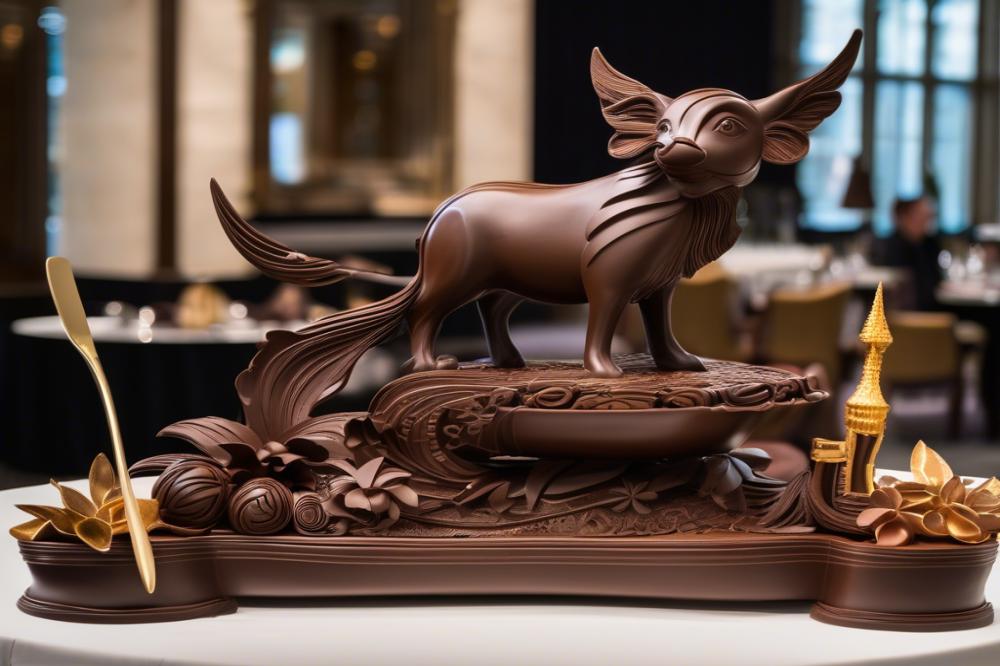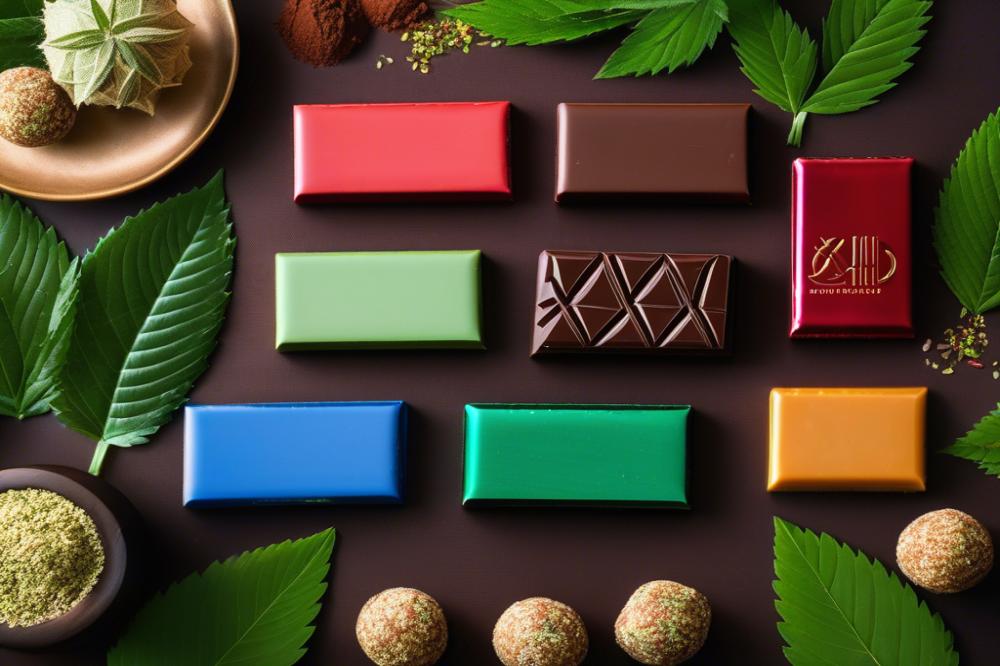Innovations in chocolate sculptures and Installations
The chocolate industry has seen remarkable growth over the years. From a simple treat to a multi-billion dollar enterprise, this sector continues to thrive. Many factors contribute to this expansion, including increasing global demand and the rise of gourmet products. In recent times, a fascinating trend has emerged that showcases the incredible talent of chocolatiers. They are not only creating delicious confections but are also transforming chocolate into edible art.
Dessert art holds a special place in culinary traditions. It is much more than just food; it is a form of expression. Chocolate craftsmanship has become a celebrated aspect of this art form. With skillful hands and imaginative minds, artists create striking food sculptures that capture the eye and tantalize the taste buds. chocolate sculptures and installations impress audiences as they intertwine beauty with the joy of indulgence.
Exhibitions featuring these creative desserts introduce visitors to a world where chocolate becomes a medium for artistic exploration. This growing interest in innovative designs has spurred chocolatiers to push boundaries. They experiment with new techniques and styles, almost transforming the dessert landscape. From intricate designs to monumental pieces, every chocolate creation tells a story. As we delve into the innovations within this captivating field, we will explore how artists are reshaping perceptions of dessert art and engaging audiences in novel ways.
The Evolution of Chocolate Sculptures

Chocolate craftsmanship has deep historical roots. For centuries, it served a vital role in various cultures. Ancient civilizations often used chocolate in rituals and celebrations. From these early beginnings, its use has evolved into something much more intricate. Over time, culinary artisans developed the skills to transform simple ingredients into stunning pieces of edible art.
Transitioning from traditional methods to modern approaches, the landscape of dessert art has changed significantly. As techniques advanced, so did the complexity of sculpture design. In the past, designs were more simplistic. Today, artisans often push boundaries with elaborate creations that dazzle viewers. With the introduction of new materials and tools, the possibilities seem endless.
Moreover, the impact of culinary arts cannot be overlooked. Chefs now treat food as a canvas for expression. Innovative ideas flow from the minds of these professionals, leading to spectacular exhibitions showcasing food sculptures. This blend of creativity and skill breathes new life into chocolate artistry. Enthusiasts and critics alike appreciate the dedication involved in creating each piece. Cookie brownies or cake pops may be fun, but intricate installations capture attention on another level.
As artists explore new techniques, the world witnesses a revolution in how desserts are perceived. What was once merely sweet indulgence has transformed into captivating masterpieces. With each new design, they tell stories and evoke emotions. Great chocolate sculptures challenge the boundaries of what one can do with food. This ever-evolving art form continues to inspire future generations of creators.
Current Innovations in Chocolate Sculptures

Use of Technology in Sculpture Design and Creation
Technology is reshaping the way artists approach food sculptures. Advanced software allows designers to create intricate patterns and details that would be almost impossible by hand. Digital modeling software can visualize designs before any chocolate touches the surface. Artists can now plan their work with precision, breaking boundaries in traditional culinary arts. These tools not only enhance creativity but also streamline the entire process, making it more efficient.
Exploration of New Techniques and Materials
Innovative techniques are emerging in the world of dessert art. One popular method is the use of airbrushing, which adds depth and color to chocolate creations. Artists also experiment with various types of chocolate, including white, dark, and even ruby chocolate. Each type has unique melting points and textures, influencing how they can be sculpted. Additionally, incorporating flavor-infused chocolates introduces exciting taste variations, captivating audiences’ palates.
Integration of 3D Printing in Edible Art
3D printing is revolutionizing the creation of chocolate masterpieces. This technology allows chefs to craft detailed designs with incredible accuracy. Using a food-safe 3D printer, they can produce elaborate structures that would require exhaustive manual effort otherwise. This innovation raises the bar for chocolate craftsmanship while showcasing the future of food design. With it, artists can push the limits of edible art, making complex shapes and forms accessible to both chefs and hobbyists alike.
Exhibitions are increasingly showcasing these advancements, blending art and technology. Attendees often find themselves marveling at creations that look too stunning to eat. The intersection of art and culinary skills is becoming a fascinating trend, promising exciting developments in the years to come.
Notable Exhibitions and Installations

Renowned Exhibitions Showcasing Chocolate Sculptures
Every year, various exhibitions around the globe celebrate the artistry and craftsmanship of chocolate. Events such as the Salon du Chocolat in Paris attract top chocolatiers and artists alike. Here, visitors can marvel at creations that blend food sculptures and expert design. These showcases highlight the creativity involved in dessert art and enhance the appreciation of chocolate as a medium. Artists display everything from life-sized chocolate statues to intricate pieces that vanish after a few bites. The connection between culinary arts and visual art emerges vividly at these exhibitions.
Festival Events and Culinary Competitions
Chocolate festivals bring together enthusiasts and professionals to explore edible art. Competitions like the World Chocolate Masters invite chocolatier innovators to present their best work. In such contests, participants push the boundaries of chocolate craftsmanship. They create stunning displays that impress both the judges and the audience. These events are not just about winning; they focus on creativity and the joy of food. Seeing the public reactions to these flavorful masterpieces adds to the excitement. Tasting and enjoying these creations fosters a deeper appreciation for the art of chocolate.
Case Studies of Famous chocolate installations Worldwide
Notable installations emerge in cities known for their culinary influence. One famous case is the massive “Chocolate City” created in 2014 for a festival in Italy. This project involved collaborating artists who crafted entire neighborhoods out of chocolate. Visitors enjoyed walking through the streets of this edible landscape, completely engulfed in sweet aromas. Another impressive example is the annual Ice Cream and Chocolate Festival in the United States. Here, structures made of chocolate delight crowds and showcase remarkable sculpture design. Each installation tells a story while inviting guests to interact with dessert art in imaginative ways.
Culinary and Artistic Collaboration
Collaboration between chefs and artists has become a powerful trend in the world of chocolate craftsmanship. Chefs who specialize in desserts are now exploring new ways to blend culinary arts with art. This partnership creates something truly special, transforming everyday food into edible art. It’s not just about taste anymore; it’s about visual impact and creativity.
Artistry in dessert art offers a fresh perspective on traditional confectionery. Chefs are redefining how we see desserts by designing innovative sculptures that capture attention. Their creations often resemble fine art pieces, encouraging diners to appreciate not just flavors, but also textures and forms. Imagine walking into a bakery and seeing intricate food sculptures that look too beautiful to eat. These artistic desserts spark conversations and provoke curiosity.
Workshops play a vital role in this rise of innovation. They provide training for aspiring chefs and artists. During these sessions, participants gain hands-on experience in sculpture design. Mentorship is an essential aspect, where seasoned professionals share their skills. Such environments foster creativity and inspire new ideas. Individuals leave these workshops with newfound confidence and knowledge, ready to contribute to the world of chocolate.
Exhibitions showcase the evolution of these creative desserts. Events centered around edible art attract a diverse audience. Visitors are amazed by the level of detail and creativity involved in each piece. This blend of art and food captivates the imagination. It encourages a dialogue about how we can push boundaries in both the culinary and artistic fields.
In summary, the fusion of culinary arts with artistry has opened up exciting avenues. Chocolate craftsmanship has evolved into a dynamic form of expression. Creative desserts now hold a place in the gallery as much as they do on the table. This collaboration is not just changing the way we view desserts; it is redefining what food can be.
Sustainability in Chocolate Sculpture Production
Emerging awareness of environmental issues is changing the way chocolate is sourced. Consumers now prefer products that are environmentally friendly. The trend towards sustainable chocolate sourcing is gaining momentum. Many chocolatiers are choosing Fair Trade and organic beans. This commitment reflects a desire to protect ecosystems and support local farmers.
Innovative approaches in materials and processes are transforming the industry. Artisans are exploring alternative sweeteners and natural flavors. Some use plant-based ingredients in their dessert art. This shift not only enhances flavors but also reduces the carbon footprint of production. Edible art made from sustainable materials is becoming more common in exhibitions and shows.
These developments impact the future of food sculptures significantly. As sustainability becomes a priority, the focus on traditional chocolate craftsmanship may diminish. New designs will likely emphasize eco-friendliness while still showcasing artistic talent. Consumers will support brands that align with eco-conscious values. This creates a market for creative desserts that are both beautiful and kind to the planet.
The fusion of artistry and sustainability presents an exciting opportunity for artists. They can integrate ethical practices into their sculpture design. This change is not just a trend; it represents a shift in the culinary arts. By accepting it, chocolatiers can craft pieces that tell a story of responsibility. As a result, chocolate sculptures may evolve into symbols of innovation and environmental stewardship.
Final Thoughts on Innovations in Edible Art
Innovations in chocolate sculptures have transformed the way we perceive edible art. These creations demonstrate not just skill but also an impressive level of creativity. Each piece tells a story and offers a sensory experience that delights both the eyes and the palate. Artists push the limits, exploring various techniques and materials to create standout installations. They bring a unique blend of flavor and visual appeal to events, celebrations, and exhibitions.
The future looks bright for edible artistry in the culinary arts. As technology advances and more chefs embrace this form of expression, we can expect to see even more breathtaking installations. Virtual reality could play a role, allowing people to experience these artworks in new ways. Collaborative projects between sculptors and pastry chefs might unlock new techniques and ideas. People are eager to see how artistry will change and evolve.
Ultimately, the importance of creativity in the realm of chocolate cannot be overstated. It inspires others to explore their own abilities in the kitchen and beyond. Innovations challenge traditions and invite all of us to think outside the box. Just as traditional art evolves, edible art will continue to surprise and engage audiences. Supporting these artists and their imaginative endeavors helps to celebrate food not just as fuel, but as a beautiful and engaging experience.



